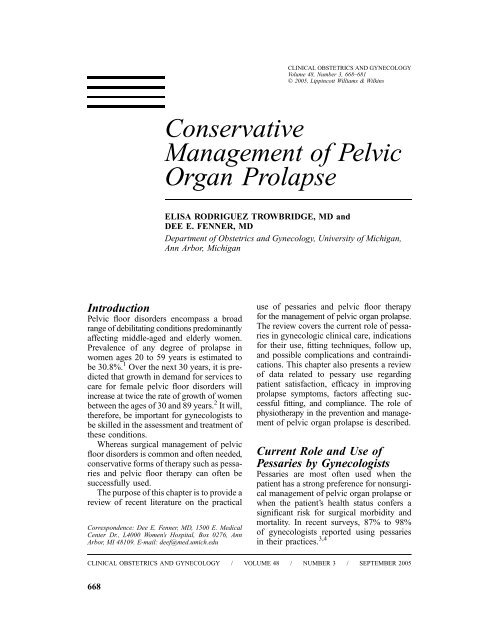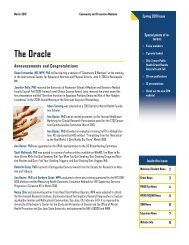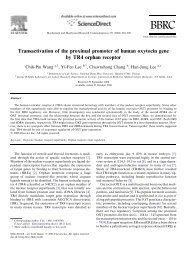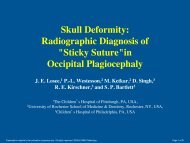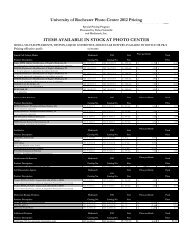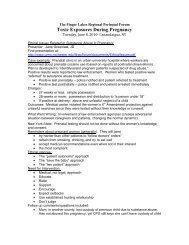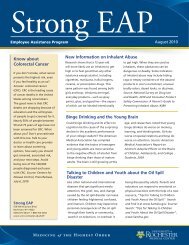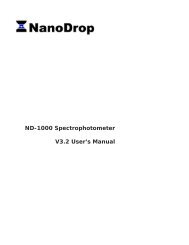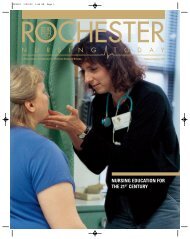Conservative Management of Pelvic Organ Prolapse
Conservative Management of Pelvic Organ Prolapse
Conservative Management of Pelvic Organ Prolapse
You also want an ePaper? Increase the reach of your titles
YUMPU automatically turns print PDFs into web optimized ePapers that Google loves.
<strong>Conservative</strong><br />
<strong>Management</strong> <strong>of</strong> <strong>Pelvic</strong><br />
<strong>Organ</strong> <strong>Prolapse</strong><br />
ELISA RODRIGUEZ TROWBRIDGE, MD and<br />
DEE E. FENNER, MD<br />
Department <strong>of</strong> Obstetrics and Gynecology, University <strong>of</strong> Michigan,<br />
Ann Arbor, Michigan<br />
Introduction<br />
<strong>Pelvic</strong> floor disorders encompass a broad<br />
range <strong>of</strong> debilitating conditions predominantly<br />
affecting middle-aged and elderly women.<br />
Prevalence <strong>of</strong> any degree <strong>of</strong> prolapse in<br />
women ages 20 to 59 years is estimated to<br />
be 30.8%. 1 Over the next 30 years, it is predicted<br />
that growth in demand for services to<br />
care for female pelvic floor disorders will<br />
increase at twice the rate <strong>of</strong> growth <strong>of</strong> women<br />
between the ages <strong>of</strong> 30 and 89 years. 2 It will,<br />
therefore, be important for gynecologists to<br />
be skilled in the assessment and treatment <strong>of</strong><br />
these conditions.<br />
Whereas surgical management <strong>of</strong> pelvic<br />
floor disorders is common and <strong>of</strong>ten needed,<br />
conservative forms <strong>of</strong> therapy such as pessaries<br />
and pelvic floor therapy can <strong>of</strong>ten be<br />
successfully used.<br />
The purpose <strong>of</strong> this chapter is to provide a<br />
review <strong>of</strong> recent literature on the practical<br />
Correspondence: Dee E. Fenner, MD, 1500 E. Medical<br />
Center Dr., L4000 Women’s Hospital, Box 0276, Ann<br />
Arbor, MI 48109. E-mail: deef@med.umich.edu<br />
CLINICAL OBSTETRICS AND GYNECOLOGY<br />
Volume 48, Number 3, 668–681<br />
Ó 2005, Lippincott Williams & Wilkins<br />
use <strong>of</strong> pessaries and pelvic floor therapy<br />
for the management <strong>of</strong> pelvic organ prolapse.<br />
The review covers the current role <strong>of</strong> pessaries<br />
in gynecologic clinical care, indications<br />
for their use, fitting techniques, follow up,<br />
and possible complications and contraindications.<br />
This chapter also presents a review<br />
<strong>of</strong> data related to pessary use regarding<br />
patient satisfaction, efficacy in improving<br />
prolapse symptoms, factors affecting successful<br />
fitting, and compliance. The role <strong>of</strong><br />
physiotherapy in the prevention and management<br />
<strong>of</strong> pelvic organ prolapse is described.<br />
Current Role and Use <strong>of</strong><br />
Pessaries by Gynecologists<br />
Pessaries are most <strong>of</strong>ten used when the<br />
patient has a strong preference for nonsurgical<br />
management <strong>of</strong> pelvic organ prolapse or<br />
when the patient’s health status confers a<br />
significant risk for surgical morbidity and<br />
mortality. In recent surveys, 87% to 98%<br />
<strong>of</strong> gynecologists reported using pessaries<br />
in their practices. 3,4<br />
CLINICAL OBSTETRICS AND GYNECOLOGY / VOLUME 48 / NUMBER 3 / SEPTEMBER 2005<br />
668
Pessary Efficacy in Improving<br />
<strong>Prolapse</strong> Symptoms<br />
Only a few studies have evaluated the efficacy<br />
and patient satisfaction <strong>of</strong> pessaries<br />
in relieving symptoms <strong>of</strong> prolapse. Clemons<br />
5–7 followed 100 women fitted with pessaries<br />
for stage II prolapse for changes in<br />
prolapse and urinary symptoms. At 2 months,<br />
92% <strong>of</strong> women fitted with a pessary were<br />
satisfied. Nearly all prolapse symptoms<br />
(bulge, pressure, discharge, and splinting)<br />
had resolved and concurrent urinary symptoms<br />
(baseline stress incontinence, urge<br />
incontinence, and voiding difficulty) had<br />
improved in approximately half <strong>of</strong> patients.<br />
However, among women with no urinary<br />
symptoms at baseline, 21% complained <strong>of</strong><br />
occult (de novo) incontinence with pessary<br />
use.<br />
Many clinicians have noted the decrease<br />
in prolapse stage after long-term pessary<br />
use and the successful role <strong>of</strong> pessaries in<br />
preventing progression <strong>of</strong> prolapse. One<br />
small study suggested that there was a therapeutic<br />
effect <strong>of</strong> wearing a supportive pessary<br />
as evidenced by an improvement <strong>of</strong><br />
stage <strong>of</strong> pelvic organ prolapse in 21% <strong>of</strong><br />
patients followed for 1 year. 8 The authors<br />
speculate that the mechanism <strong>of</strong> this improvement<br />
might be the result <strong>of</strong> improved<br />
levator ani function, and that pessary support<br />
<strong>of</strong> pelvic organs may allow for recovery<br />
<strong>of</strong> passive stretch, thus improving levator<br />
function and muscular support <strong>of</strong> pelvic<br />
organs.<br />
Factors Effecting Successful<br />
Pessary Fitting<br />
Achieving optimal results and satisfaction<br />
with pessary use requires accurate identification<br />
<strong>of</strong> appropriate patient candidates<br />
and proper choice <strong>of</strong> pessary type. Successful<br />
pessary fitting rates range from 56% to<br />
74%. The two studies with the highest rates<br />
<strong>of</strong> success used similar protocols. Patients<br />
were first fitted with ring pessaries and, if<br />
expelled, a space-filling pessary such as<br />
the Gellhorn was then attempted.<br />
<strong>Conservative</strong> <strong>Management</strong> <strong>of</strong> <strong>Pelvic</strong> <strong>Organ</strong> <strong>Prolapse</strong> 669<br />
Important in the discussion <strong>of</strong> successful<br />
pessary fitting is to speculate which patients<br />
are likely to choose pessary management<br />
over surgery or expectant management. A<br />
study evaluating the clinical factors that<br />
affect a patient’s treatment choice for symptomatic<br />
pelvic organ prolapse found that<br />
older patients (age 70 ± 12 years) were<br />
10% more likely to choose pessary over surgery.<br />
History <strong>of</strong> prior pelvic surgery, on the<br />
other hand, was the strongest predictor <strong>of</strong> a<br />
patient choosing surgery as their form <strong>of</strong><br />
treatment. 9<br />
Clemons et al fitted 100 women with pessaries<br />
for symptomatic pelvic organ prolapse<br />
and found that no patient demographic<br />
or comorbidity could be identified as a risk<br />
factor for an unsuccessful pessary fitting<br />
trial. However, this study did find an association<br />
with shorter vaginal length (#6 cm)<br />
and wider vaginal introitus (4 finger breaths)<br />
on pelvic examination predicted an unsuccessful<br />
pessary fitting trial. Interestingly,<br />
stage III or IV prolapse in each compartment<br />
(anterior vaginal wall, posterior vaginal<br />
wall, and vault/uterine prolapse) was not a<br />
risk factor for an unsuccessful fitting. A similar<br />
study also evaluated variables, which<br />
would diminish a patient’s ability to retain<br />
a pessary. In this particular study, physical<br />
examination findings that predicted a<br />
patient’s inability to retain a pessary were<br />
absence <strong>of</strong> sacral reflexes, inability to Kegel,<br />
higher stage <strong>of</strong> prolapse, and an enlarged<br />
genital hiatus (greater than 4 cm). 10<br />
Factors Affecting Continued<br />
Pessary Use<br />
Factors that affect a patient’s likelihood to<br />
continue with pessary use have been evaluated<br />
by several studies. Clemons et al<br />
found that 72% <strong>of</strong> women satisfied with<br />
their pessary after 2 months continued to<br />
use their pessary after 1 year and 64% continued<br />
use after 2 years. In their study, older<br />
age (.65 years) was the strongest predictor<br />
<strong>of</strong> continued pessary use after a successful<br />
fitting. Stage III and IV posterior wall prolapse
670 Trowbridge and Fenner<br />
was associated with discontinued use <strong>of</strong> the<br />
pessary. This finding is not surprising<br />
because anecdotally, women with large posterior<br />
wall defects are less likely to experience<br />
relief <strong>of</strong> their prolapse symptoms with<br />
pessary use. Initial desire for surgical management<br />
<strong>of</strong> prolapse symptoms was also<br />
found to be associated with discontinued<br />
use <strong>of</strong> pessaries. Brincat 11 performed a retrospective<br />
chart review <strong>of</strong> 136 current<br />
‘‘users’’ versus ‘‘nonusers’’ (women who stopped<br />
wearing the pessary during the study<br />
period) to determine clinical variables predicting<br />
continued pessary use. The authors<br />
reported that women with prolapse and<br />
incontinence or prolapse alone were more<br />
likely to continue with long-term pessary<br />
use than women with isolated incontinence.<br />
Their most significant finding <strong>of</strong> this study<br />
was that long-term pessary use was acceptable<br />
to sexually active women.<br />
In summary, there is insufficient evidence<br />
to allow a practitioner to know which patients<br />
are likely to accept and continue pessary<br />
use. Therefore, all patients with symptomatic<br />
prolapse should be <strong>of</strong>fered conservative<br />
management <strong>of</strong> prolapse using pessaries.<br />
Indications<br />
Indications for pessary use are:<br />
• Primary therapy for prolapse symptoms<br />
• Diagnosis and preoperative evaluation <strong>of</strong> patients<br />
with pelvic prolapse<br />
• Temporary treatment <strong>of</strong> prolapse symptoms<br />
• Urinary incontinence and obstetric indications<br />
PRIMARY THERAPY<br />
The pessary has 4 primary indications. The<br />
first and most common, is the relief <strong>of</strong> prolapse<br />
symptoms as initial treatment or recurrence<br />
<strong>of</strong> prolapse.<br />
DIAGNOSIS AND PREOPERATIVE<br />
EVALUATION<br />
The second indication for pessary use is to<br />
diagnose symptoms associated with genital<br />
prolapse before surgery. Occult incontinence,<br />
urinary retention, and pelvic pain<br />
are conditions that should be evaluated preoperatively<br />
to allow for comprehensive<br />
counseling as to the best surgical or nonsurgical<br />
form <strong>of</strong> treatment. A recent study<br />
addressed the question <strong>of</strong> whether preoperative<br />
reduction <strong>of</strong> the anterior vaginal wall in<br />
patients with urinary retention (postvoid<br />
residual [PVR] $100 cc) with a pessary<br />
would predict voiding function after reconstructive<br />
surgery. Lazarou 12 concluded that<br />
pessary reduction <strong>of</strong> the anterior vaginal<br />
wall in patients with urinary retention has<br />
good sensitivity, specificity, and positive<br />
predictive value for postoperative voiding<br />
function.<br />
TEMPORARY TREATMENT<br />
Preoperatively, a pessary can be useful in the<br />
healing <strong>of</strong> vulvar erosions secondary to a<br />
large prolapse. Second, mechanical devices<br />
can be used as an interim measure while a<br />
patient prepares for surgery and considers<br />
nonsurgical options for relief <strong>of</strong> symptoms.<br />
In a similar manner, younger women will<br />
benefit from the symptomatic relief <strong>of</strong> their<br />
prolapse symptoms as they wait to complete<br />
childbearing.<br />
URINARY INCONTINENCE AND<br />
OBSTETRIC INDICATIONS<br />
Pessaries are an important conservative<br />
mode <strong>of</strong> therapy used for urinary incontinence<br />
as well as the use <strong>of</strong> pessaries in<br />
obstetrics for the management <strong>of</strong> an incarcerated<br />
uterus or incompetent cervix. Pessaries<br />
designed to support the urethrovesical<br />
junction with a knob or prongs may be successful<br />
alternatives for surgery for the management<br />
<strong>of</strong> stress incontinence with a success<br />
rate ranging from 15% to 59%. 13 In<br />
obstetrics, pessary use has been reported<br />
in the first trimester for the treatment <strong>of</strong><br />
incarcerated uterus. Rarely pessaries have<br />
been used in cases <strong>of</strong> incompetent cervix.<br />
A recent review <strong>of</strong> the use <strong>of</strong> pessaries in<br />
women at risk for preterm delivery reports<br />
that they might be helpful and seem to be
without risks. However, the existing data are<br />
limited by a lack <strong>of</strong> inclusion criteria and<br />
selection bias. The review recommends that<br />
pessaries be used as an adjunct to cerclage<br />
and not to replace the use <strong>of</strong> cerclages in<br />
the treatment <strong>of</strong> incompetent cervix. 14<br />
Patient Evaluation<br />
HISTORY<br />
The evaluation <strong>of</strong> a patient for a pessary<br />
must be made in the context <strong>of</strong> her daily<br />
activities, level <strong>of</strong> functioning, and the impact<br />
<strong>of</strong> pelvic organ prolapse on her quality <strong>of</strong><br />
life. In addition, the patient’s specific prolapse<br />
symptoms must be identified. As discussed<br />
previously, most symptoms <strong>of</strong> prolapse<br />
(bulge, pressure, discharge, and splinting)<br />
are effectively relieved by pessaries. 5–7<br />
Urinary symptoms have been shown to<br />
improve or worsen with pessaries. Patients<br />
with chronic constipation may have difficulty<br />
retaining a pessary. The pessary may<br />
increase defecation symptoms such as difficult<br />
evacuation.<br />
The patient’s general health status must<br />
also be assessed. Although ideally, a patient<br />
would care for her own pessary, some need<br />
following by a physician for regular pessary<br />
checks. In planning for their follow up, it is<br />
also important to ascertain a patient’s living<br />
situation and their access to medical care.<br />
Undoubtedly, a neglected pessary presents<br />
a clinical dilemma for most physicians<br />
because most <strong>of</strong> these patients are typically<br />
poor surgical candidates. A sexual history<br />
should be included because recent data demonstrates<br />
that sexually active women find<br />
pessaries an acceptable long-term treatment<br />
option. 11 Ultimately, one <strong>of</strong> the most important<br />
components <strong>of</strong> a pessary evaluation is<br />
an assessment <strong>of</strong> the patient’s capacity to understand<br />
the pessary’s function, maintenance,<br />
and the importance <strong>of</strong> medical follow up.<br />
PHYSICAL EXAMINATION<br />
Some <strong>of</strong> the key components <strong>of</strong> the physical<br />
examination pertain to the patient’s pelvic<br />
<strong>Conservative</strong> <strong>Management</strong> <strong>of</strong> <strong>Pelvic</strong> <strong>Organ</strong> <strong>Prolapse</strong> 671<br />
floor strength, severity <strong>of</strong> prolapse, specific<br />
pelvic floor defects, and health <strong>of</strong> the vaginal<br />
epithelium.<br />
<strong>Pelvic</strong> Floor Assessment<br />
Evaluation begins with careful examination<br />
<strong>of</strong> the external genitalia for signs <strong>of</strong> excoriation<br />
and erythema, which may be present<br />
after prolonged complete vault or uterine<br />
prolapse. The size <strong>of</strong> the genital hiatus<br />
(defined as middle <strong>of</strong> the external urethral<br />
meatus to the posterior midline hymen) is<br />
measured, and a size greater than 4 to 5 cm<br />
is generally felt to be enlarged. Vaginal<br />
depth and caliber is estimated by digital vaginal<br />
examination. <strong>Pelvic</strong> floor strength is important<br />
in retaining a pessary, and it is evaluated<br />
by placing 2 fingers in the patient’s<br />
vagina and asking her to perform a Kegel<br />
contraction.<br />
<strong>Prolapse</strong> Severity and Specific <strong>Pelvic</strong><br />
Floor Defects<br />
The severity <strong>of</strong> pelvic organ prolapse and<br />
the site-specific defects are evaluated by<br />
examining a patient in a semirecumbent dorsal<br />
lithotomy position. The patient is asked<br />
to perform a Valsalva maneuver and possibly<br />
cough to demonstrate the maximum extent<br />
<strong>of</strong> the prolapse. If the maximum protrusion<br />
is demonstrated, the vaginal walls will<br />
appear tight, and it is essential to confirm<br />
with the patient if this is the most severe protrusion<br />
that she experiences. If it is difficult<br />
to differentiate which part <strong>of</strong> the vagina is<br />
prolapsing, half <strong>of</strong> a speculum is used to<br />
reduce the prolapse to ascertain which wall<br />
<strong>of</strong> the vagina most prolapsed.<br />
Health <strong>of</strong> the Vaginal Epithelium<br />
Evaluation for vaginal and vulvar atrophy<br />
secondary to estrogen deficiency should be<br />
assessed on examination. Little to no data<br />
is currently available to dictate whether vaginal<br />
atrophy is indeed a contraindication for<br />
pessary fitting. Wu and colleagues 15 reported<br />
on their experience with 110 women who<br />
were prospectively enrolled in a study
672 Trowbridge and Fenner<br />
evaluating a pessary protocol. They reported<br />
that hormone replacement therapy (HRT)<br />
did not predict successful pessary fitting.<br />
Moreover, the health <strong>of</strong> the vaginal epithelium<br />
was recorded in 75 <strong>of</strong> these women,<br />
and no correlation was found between current<br />
hormone replacement status and vaginal<br />
abrasions rates. However, the incidence<br />
<strong>of</strong> vaginal abrasions was increased significantly<br />
as the vaginal epithelium became<br />
thinner This study points out that it is difficult<br />
to control for various aspects <strong>of</strong> HRT<br />
and its role in maintaining healthy vaginal<br />
epithelium with pessary use. These factors<br />
include the type, route, frequency, and<br />
length <strong>of</strong> treatment <strong>of</strong> hormone therapy.<br />
Most experts would advocate local estrogen<br />
therapy in pessary users provided that there<br />
are no contraindications to its use. Recent<br />
studies have shown that oral HRT/estrogen<br />
replacement therapy (ERT) provides no<br />
functional improvement <strong>of</strong> the lower urinary<br />
tract. 16 To definitively answer the question<br />
<strong>of</strong> estrogen use and pessaries, we need trials<br />
on type, route, frequency, and so on.<br />
Choosing a Pessary<br />
There are 2 general categories <strong>of</strong> pessaries<br />
for the management <strong>of</strong> pelvic organ prolapse:<br />
1) support pessaries and 2) spacefilling<br />
pessaries (Table 2). Support pessaries<br />
such as the ring pessary use a spring mechanism<br />
that rests in the posterior fornix and<br />
against the posterior aspect <strong>of</strong> the pubic<br />
symphysis. 17 The space-filling devices, such<br />
as the cube pessary, function by creating<br />
suction between the device and the vaginal<br />
walls, or by merely occupying a space larger<br />
than the genital hiatus as demonstrated by<br />
the donut pessary. The Gellhorn pessary is<br />
thought to function through a combination<br />
<strong>of</strong> these latter 2 mechanisms.<br />
Currently available pessaries are made <strong>of</strong><br />
flexible silicone or less frequently latex<br />
material. The advantages <strong>of</strong> silicone or other<br />
inert plastics include convenient patient insertion<br />
and removal, lack <strong>of</strong> allergenic potential,<br />
greatly reduced odor absorption, and their<br />
durability. Rigid pessaries are no longer recommended,<br />
and if found on a patient’s<br />
examination, they should be removed.<br />
There are 2 generally accepted approaches<br />
to choosing and fitting a pessary to manage<br />
symptomatic pelvic prolapse. Most commonly,<br />
a physician will choose a pessary<br />
based on the specific support defects (complete<br />
uterine prolapse, anterior, apical, or<br />
posterior wall defect). A second approach<br />
involves using the same pessary for all<br />
defects.<br />
Currently, neither approach has been proven<br />
more effective than the other. A survey<br />
given to members <strong>of</strong> the American Urogynecologic<br />
Society found that a majority <strong>of</strong><br />
responding physicians (78%) tailored their<br />
choice <strong>of</strong> pessary to the specific support<br />
defect. The findings <strong>of</strong> this survey point to<br />
the fact that the pessaries most commonly<br />
in use are the ring, Gellhorn, and the donut<br />
pessary. What specific defects are most<br />
improved by mechanical devices is a question<br />
for which there is no clear data on<br />
which to make clinical recommendations.<br />
Table 1 reports the pessary choices <strong>of</strong> a<br />
survey <strong>of</strong> members <strong>of</strong> the American Urogynecologic<br />
Society.<br />
Despite the lack <strong>of</strong> evidence that any 1<br />
pessary is best in managing a patient’s<br />
symptoms, most experts would agree on<br />
some basic tenets. Anterior vaginal wall<br />
defects (cystoceles) are best managed with<br />
ring pessaries or lever pessaries (Smith-<br />
Hodge). Stage II apical (middle) compartment<br />
defects (uterine, vaginal vault, enterocele)<br />
are also well suited to management with ring<br />
pessaries. Gellhorns are best suited for stage<br />
III or stage IV uterine prolapse or vaginal<br />
vault prolapse. The donut pessary can also<br />
be helpful in managing complete uterine<br />
prolapse or vault eversion. Posterior vaginal<br />
wall defects have traditionally not been felt<br />
to be as adequately managed with pessaries.<br />
This is likely the result <strong>of</strong> the design <strong>of</strong> most<br />
pessaries, which function through either the<br />
support <strong>of</strong> the pessary resting against the<br />
pubic symphysis and anterior or apical<br />
compartment. For this reason, the donut, a
TABLE 1. Choices <strong>of</strong> Pessary by Support Defects Among Physicians Who Tailor the Pessary to<br />
the Support Defects<br />
Support Defect<br />
Physician Response<br />
Anterior Posterior Apical Procidentia<br />
Would use pessary 89% 60% 74% 76%<br />
First choice Ring Donut Ring Gellhorn<br />
Second choice Hodge Risser Gellhorn Donut<br />
space-occupying pessary, can be attempted<br />
for the relief <strong>of</strong> symptoms <strong>of</strong> a rectocele.<br />
In addition to the specific vaginal wall<br />
defects, pelvic floor muscle strength is<br />
another factor to consider in choosing a pessary.<br />
A wide genital hiatus is generally<br />
attributable to damaged levator muscles. If<br />
the patient is unable to contract the pelvic<br />
floor, most authors generally recommend<br />
using a space-filling pessary versus a support<br />
pessary.<br />
Also important in choosing a pessary is to<br />
consider whether a patient will be removing<br />
and reinserting the pessary at home or<br />
returning to the <strong>of</strong>fice for regular pessary<br />
checks. The ring’s design makes it a very<br />
desirable candidate for a patient who wants<br />
to care for her pessary as a result <strong>of</strong> its ease<br />
<strong>of</strong> insertion and removal. The Gellhorn and<br />
donut, on the other hand, can be quite difficult<br />
to remove even for experienced practitioners,<br />
and for this reason, these types <strong>of</strong><br />
pessaries are generally best cared for in an<br />
outpatient setting.<br />
Fitting and Insertion<br />
Fitting <strong>of</strong> pessaries requires trial and error<br />
with a goal <strong>of</strong> fitting the largest possible pessary<br />
that does not cause discomfort. It is helpful<br />
to have various types <strong>of</strong> pessaries in different<br />
sizes available in the examination room.<br />
GENERAL PROCEDURE<br />
The patient is first asked to empty her bladder<br />
before the fitting. A digital examination<br />
is then performed to assess both vaginal<br />
length and caliber with the patient in a dorsal<br />
lithotomy position. A small amount <strong>of</strong><br />
water-based lubricant is then placed on the<br />
<strong>Conservative</strong> <strong>Management</strong> <strong>of</strong> <strong>Pelvic</strong> <strong>Organ</strong> <strong>Prolapse</strong> 673<br />
leading edge <strong>of</strong> the pessary. Once the pessary<br />
is in place, the physician’s finger should<br />
easily fit between the circumference <strong>of</strong> the<br />
pessary and the vaginal wall. With the labia<br />
separated, the patient is asked to bear down<br />
at which time some movement <strong>of</strong> the pessary<br />
will be seen. The examiner should ask the<br />
patient to sit, stand, and ambulate in the<br />
clinic and attempt to void with the pessary<br />
in place. A helpful test is to place a hat on<br />
the toilet and have the patient attempt to defecate.<br />
For many women, this type <strong>of</strong> exertion<br />
is likely to expel the pessary once she<br />
leaves the <strong>of</strong>fice. A successful pessary fitting<br />
is defined as 1) pessary not expelled with Valsalva<br />
or cough; and 2) patient comfortable and<br />
not aware <strong>of</strong> the pessary in the vagina with<br />
ambulation, voiding, sitting, and defecation.<br />
Ring<br />
As previously mentioned, the ring pessary is<br />
the most widely used pessary for management<br />
<strong>of</strong> prolapse symptoms. Its popularity,<br />
in all likelihood, is the result <strong>of</strong> its simple<br />
design, similar to a diaphragm, and its ease<br />
for insertion and fitting. Typically, the use <strong>of</strong><br />
ring pessaries has been designated for less<br />
severe forms <strong>of</strong> uterine and vaginal vault<br />
prolapse. Likewise, most clinicians will<br />
also use rings for management <strong>of</strong> symptomatic<br />
cystoceles. The ring is available with<br />
and without support, the advantage <strong>of</strong> the<br />
support being that theoretically it prevents<br />
incarceration <strong>of</strong> the cervix. The ring is inserted<br />
by folding the device in half and<br />
pointing the arc so that it faces downward.<br />
Once inserted in the vagina, it is then oriented<br />
past the cervix into the posterior<br />
fornix and behind the pubic symphysis.
674 Trowbridge and Fenner<br />
TABLE 2. Most Common Pessaries and Their Use<br />
Pessary Type Indication Pros Cons<br />
Ring with support<br />
Gellhorn<br />
Donut<br />
Inflatoball<br />
Cube<br />
Photo courtesy <strong>of</strong> Milex Products, Inc.<br />
Support Mild uterine<br />
and vaginal<br />
prolapse;<br />
cystocele<br />
Space-filling Uterine and<br />
vaginal<br />
prolapse<br />
Space-filling Uterine and<br />
vaginal<br />
prolapse<br />
Space-filling Uterine and<br />
vaginal<br />
prolapse<br />
Space-filling Uterine and<br />
vaginal<br />
prolapse<br />
Gellhorn<br />
The Gellhorn is typically used to manage<br />
apical and anterior moderate to severe prolapse<br />
and uterine procidentia. The concave surface<br />
<strong>of</strong> the device is designed to rest against the<br />
cervix or suctioned to the upper vagina if the<br />
Easy insertion<br />
and removal<br />
Coitus possible<br />
Ideal for III<br />
and IV<br />
prolapse<br />
Ideal for stage III<br />
and IV prolapse<br />
Less helpful<br />
for more severe<br />
forms <strong>of</strong> prolapse<br />
Difficult insertion and<br />
removal for patient<br />
Coitus not possible<br />
Difficult insertion<br />
and removal for<br />
patient<br />
Coitus not possible<br />
Easy insertion Difficult to retain<br />
Ideal for stage III<br />
and IV prolapse<br />
Vaginal ulcerations<br />
Heavy discharge<br />
Frequent removal<br />
cervix is absent. The stem <strong>of</strong> the pessary<br />
points to the posterior vaginal wall adjacent<br />
to the introitus. The patient’s ability to retain<br />
this device will be incumbent on the patient<br />
having an intact perineal body. To insert the<br />
Gellhorn, the labia are separated and the
device introduced in an oblique angle with<br />
some pressure exerted on the introitus. To<br />
remove the device, the stem is grasped<br />
and the suction broken by gently rocking<br />
the device side to side. Downward displacement<br />
<strong>of</strong> the perineum is helpful in removing<br />
the device. Typically, this pessary is not easy<br />
to remove and for that reason, the device is<br />
usually managed in an outpatient setting.<br />
Donut/Inflatoball<br />
The donut and Inflatoball are 2 space-occupying<br />
pessaries used traditionally for management<br />
<strong>of</strong> stage III and IV uterine and vaginal<br />
vault prolapse. The donut is made <strong>of</strong> a<br />
silicone, whereas the Inflatoball is made <strong>of</strong><br />
latex and inflated once inserted in the vagina.<br />
Unlike the Gellhorn, both <strong>of</strong> these devices<br />
do not necessitate that a patient have an<br />
intact perineal body or competent levator ani<br />
muscles. The Inflatoball is similar in its shape<br />
and mechanism as compared with the donut,<br />
however, the advantage being that this device<br />
can be inflated with air once it is placed in<br />
the patient’s vagina. This can be helpful in<br />
patients who generally are unable to tolerate<br />
the insertion <strong>of</strong> a donut device but otherwise<br />
do not have an intact perineal body. Because<br />
the Inflatoball is made <strong>of</strong> latex and likely to<br />
absorb odors, it needs to be removed and<br />
cleansed every 2 to 3 days. Its insertion is<br />
not unlike that <strong>of</strong> the Gellhorn in that the<br />
pessary is inserted in an oblique angle with<br />
the labia separated and pressure applied to<br />
the introitus. Its removal is best performed<br />
by placing downward pressure on the perineum<br />
and gently grasping the donut and<br />
removing it in an oblique angle.<br />
Cube<br />
The cube pessary is considered a spacefilling<br />
device whose mechanism, in all likelihood,<br />
stems from the suction it creates<br />
through the concave walls it has along the<br />
6 sides <strong>of</strong> the cube. Although effective in<br />
managing stage III and IV uterine and vaginal<br />
prolapse, it is associated with increased<br />
risk <strong>of</strong> vaginal ulcerations and heavy vaginal<br />
<strong>Conservative</strong> <strong>Management</strong> <strong>of</strong> <strong>Pelvic</strong> <strong>Organ</strong> <strong>Prolapse</strong> 675<br />
discharge. For this reason, this pessary is<br />
generally more closely monitored in an outpatient<br />
setting because most patients cannot<br />
remove the device on their own. Patients<br />
may need to be seen every 4 to 6 weeks to<br />
inspect for ulcerations and to remove and<br />
clean the pessary to prevent bothersome discharge.<br />
Using a cube with fenestrations may<br />
decrease ulcerations and discharge. The discharge<br />
associated with a cube is generally<br />
secondary to desquamation and does not<br />
need antibiotic treatment. The device is<br />
inserted by pressing together 2 sides <strong>of</strong> the<br />
cube and advancing it to the most posterior<br />
and apical portion <strong>of</strong> the vagina. The removal<br />
<strong>of</strong> the device is best accomplished by breaking<br />
the suction between the device and the<br />
vaginal walls, and once this is accomplished,<br />
the walls <strong>of</strong> the cube are collapsed and<br />
gently removed.<br />
Other Available Pessaries for <strong>Prolapse</strong><br />
In addition to the aforementioned pessaries,<br />
other pessaries are available but are less<br />
commonly used for the management <strong>of</strong><br />
prolapse. The Gehrung pessary is a manually<br />
shapeable pessary with a design<br />
resembling a folded shelf. The manufacturer<br />
recommends its use in patients with cystoceles<br />
and/or rectoceles. The Shaatz pessary<br />
resembles the Gelhorn pessary but lacks the<br />
central stem. It is used for uterine and vaginal<br />
vault prolapse. Lastly, the Tandem-Cube<br />
is used for patients with stage III prolapse or<br />
uterine procidentia when a single cube provides<br />
inadequate support. See Figure 1 for<br />
currently available pessaries.<br />
Follow Up and <strong>Management</strong><br />
Current recommendations regarding follow<br />
up and management <strong>of</strong> pessaries for pelvic<br />
organ prolapse are largely based on expert<br />
opinion and case series. A prospective study<br />
sought to evaluate a more simple protocol<br />
because the authors <strong>of</strong> this study speculated<br />
that reluctance to use pessaries stems from<br />
these devices being perceived as inconvenient<br />
for physicians and patients. 15 They
676 Trowbridge and Fenner<br />
FIGURE 1. Various types <strong>of</strong> pessaries: (A)<br />
ring, (B) Shaatz, (C) Gellhorn, (D) Gellhorn,<br />
(E) ring with support, (F) Gellhorn, (G) Risser,<br />
(H) Smith, (I) tandem cube, (J) cube, (K) Hodge<br />
with knob, (L) Hodge, (M) Gehrung, (N) incontinence<br />
dish with support, (O) donut, (P) incontinence<br />
ring, (Q) incontinence dish, (R) Hodge<br />
with support, and (S) Inflatoball (latex). Photo<br />
courtesy <strong>of</strong> Milex Products, Inc.<br />
recommended that patients, at their initial<br />
fitting, be educated or given written materials<br />
on the possible symptoms and problems that<br />
may arise with the device (Table 3). Patients<br />
who report or anticipate difficulty removing<br />
the device can be taught to tie either dental<br />
floss or mon<strong>of</strong>ilament suture to the pessary<br />
to help with its removal.<br />
TABLE 3. Possible Symptoms and Problems<br />
That May Arise With the Device<br />
• Urinary incontinence<br />
• Slower urine stream<br />
• Difficulty with defecation<br />
• Discharge<br />
• Feeling <strong>of</strong> shifting <strong>of</strong> pessary<br />
• Spotting or bleeding<br />
• Spontaneous expulsion<br />
In this study protocol, after the initial fitting,<br />
patients were asked to come back in 1<br />
to 2 weeks to assess patient satisfaction, possibly<br />
refit the patient with a more comfortable<br />
pessary, or to further educate on selfcare<br />
<strong>of</strong> the device. Specifically, it is important,<br />
at this first follow-up visit, to discuss<br />
comfort, voiding, defecation, discharge,<br />
and ease <strong>of</strong> care for the patient. In the first<br />
year, patients were asked to follow up every<br />
3 months and every 6 months thereafter.<br />
At every follow-up visit, the pessary was<br />
removed, cleansed with water, and speculum<br />
examination performed to evaluate for abrasions<br />
and erosions. No serious complications<br />
were observed in this study sample.<br />
Complications and<br />
Contraindications<br />
Pessary complications are rare occurrences<br />
in medically compliant patients. The most<br />
common complications are pessary expulsion,<br />
urinary incontinence, and rectal pain,<br />
depending on the type <strong>of</strong> pessary. A commonly<br />
experienced symptom <strong>of</strong> pessary<br />
use is vaginal discharge. A study comparing<br />
pessary users with nonusers found that the<br />
presence <strong>of</strong> a foreign body increased the risk<br />
for bacterial vaginosis by 4-fold. 18 If the<br />
patient is symptomatic, bacterial vaginosis<br />
may be treated, but vaginal cultures are<br />
not recommended. Vaginal estrogen is generally<br />
recommended to patients who, at the<br />
time <strong>of</strong> their initial fitting or at subsequent<br />
follow up, are noted to have vaginal atrophy<br />
or areas ulceration or abrasions from pessary<br />
use. Typically, if ulceration occurs, the pessary<br />
is left out and the patient is advised<br />
to use intravaginal estrogen cream daily<br />
(0.5–1.0 g/d) for 2 to 3 weeks. At follow up,<br />
if the ulcerations have healed, the pessary<br />
can be replaced, and it is recommended that<br />
the patient continue to use the vaginal cream<br />
2 to 3 times per week. If ulcerations recur,<br />
despite estrogen therapy, it may be best to<br />
discontinue pessary management and consider<br />
biopsy <strong>of</strong> the site.
More serious complications associated<br />
with pessary use are generally attributable<br />
to a neglected device. Pessaries may become<br />
impacted. This is more commonly seen with<br />
space-filling pessaries such as the Gellhorn<br />
and cube pessary. These pessaries are more<br />
likely to cause vaginal erosions. Applying<br />
estrogen cream to an impacted pessary will<br />
generally aid in its removal. 19 However, an<br />
impacted pessary can require surgical<br />
removal. Other less common serious complications<br />
have been described in case<br />
reports. These include incarceration <strong>of</strong> the<br />
cervix, small bowel prolapse and incarceration,<br />
vesicovaginal fistula, and urosepsis.<br />
Generally speaking, what these reports all<br />
share in common is that the patient had<br />
not been examined by a physician for several<br />
years. This highlights the importance<br />
<strong>of</strong> evaluating patient compliance in the initial<br />
evaluation. Patients at risk for poor follow<br />
up should be considered poor candidates<br />
for pessary management.<br />
Evidence for Pessary<br />
Use (Cochrane)<br />
In 2004, 2 Cochrane Database Systematic<br />
Reviews were performed on the topics <strong>of</strong><br />
‘‘Mechanical Devices for <strong>Pelvic</strong> <strong>Organ</strong> <strong>Prolapse</strong><br />
in Women’’ and ‘‘<strong>Conservative</strong> <strong>Management</strong><br />
<strong>of</strong> <strong>Pelvic</strong> <strong>Organ</strong> <strong>Prolapse</strong> in<br />
Women.’’ 26,27 The review <strong>of</strong> mechanical<br />
devices concluded that ‘‘currently there is<br />
no evidence from randomized controlled trials<br />
(RTC) upon which to base treatment <strong>of</strong><br />
women with pelvic organ prolapse through<br />
the use <strong>of</strong> mechanical devices/pessaries.’’<br />
Likewise, the review <strong>of</strong> conservative management<br />
came to a similar conclusion that<br />
there was no evidence from RTC regarding<br />
conservative interventions in the management<br />
<strong>of</strong> pelvic organ prolapse.<br />
The conservative management review<br />
reported that evaluating the effectiveness<br />
<strong>of</strong> pelvic floor muscle training (PFMT) in<br />
treating pelvic prolapse is the most pressing<br />
research need, in that it is a costly management<br />
option. A feasibility study is currently<br />
<strong>Conservative</strong> <strong>Management</strong> <strong>of</strong> <strong>Pelvic</strong> <strong>Organ</strong> <strong>Prolapse</strong> 677<br />
underway that has an ultimate goal <strong>of</strong> progressing<br />
to a multicenter randomized trial<br />
(<strong>Pelvic</strong> <strong>Organ</strong> <strong>Prolapse</strong> Physiotherapy<br />
[POPPY]). 28 Two other randomized studies<br />
were identified by the Cochrane database<br />
that evaluated the effectiveness <strong>of</strong> PFMT<br />
in conjunction with surgery for symptomatic<br />
prolapse. One <strong>of</strong> the studies continues to<br />
recruit patients, 20 and the other has been<br />
completed and awaiting publication. 21<br />
Physiotherpy/<strong>Pelvic</strong><br />
Muscle Training<br />
One <strong>of</strong> the first descriptions <strong>of</strong> physiotherapy<br />
for restoring the function <strong>of</strong> the pelvic<br />
floor was reported by Arnold Kegel in his<br />
landmark article in 1948. 22 Stimulated by<br />
intense investigations and experiences in<br />
World War II with muscle function and recovery,<br />
he developed an exercise regimen<br />
for recovery in the immediate postpartum<br />
period. However, he speculated on the benefit<br />
<strong>of</strong> ‘‘active exercise’’ for both the prevention<br />
<strong>of</strong> pelvic organ prolapse and its added<br />
effect in improving surgical outcomes after<br />
surgical correction <strong>of</strong> pelvic prolapse. Since<br />
that time, pelvic muscle training (PMT) had<br />
been advocated for the treatment <strong>of</strong> stress<br />
urinary incontinence, pelvic organ prolapse,<br />
pelvic pain, and defecatory dysfunction.<br />
This section discusses evaluation for the<br />
appropriateness <strong>of</strong> PMT, program regimens,<br />
and techniques for teaching PMT. Lifestyle<br />
modifications and behavior therapy are<br />
briefly discussed. Lastly, this section includes<br />
recent publications on the use <strong>of</strong><br />
PMT and pelvic organ prolapse.<br />
EVALUATION FOR PELVIC<br />
MUSCLE TRAINING<br />
To evaluate the appropriateness <strong>of</strong> PMT for<br />
a woman, muscular strength, duration <strong>of</strong><br />
contraction, and extent <strong>of</strong> displacement <strong>of</strong><br />
the examining fingers is assessed. Although<br />
not standardized, a scale commonly used to<br />
assess pelvic floor strength is shown in Table 4.<br />
A woman s ability to sustain a pelvic contraction<br />
a minimum <strong>of</strong> 2 seconds is likely to<br />
ensure a better response to physiotherapy.
678 Trowbridge and Fenner<br />
TABLE 4. Five-Point Rating Scale<br />
Grade Description<br />
0 No contraction<br />
1 Flicker, only with muscles stretched<br />
2 A weak squeeze, 2-second hold<br />
3 A fair squeeze with definite ‘‘lift’’ (in which<br />
the contraction can be felt to move in<br />
an upward direction)<br />
4 A good squeeze, good hold with lift<br />
(the contraction must be able to be<br />
repeated a few times)<br />
5 A strong squeeze, good lift, repeatable<br />
Modified from Sampselle 1990.<br />
Displacement <strong>of</strong> the examiner’s finger in an<br />
inward and upward direction into the vagina<br />
is also a physical finding likely to be associated<br />
with normal structural attachments <strong>of</strong><br />
the pelvic muscles as well as intact sensory<br />
and motor innervations. A patient who on<br />
repeat attempts is unable to perform a 1/5<br />
muscle contraction is likely a poor candidate<br />
for PMT and requires more intensive pelvic<br />
floor therapy such as transvaginal electrical<br />
stimulation therapy.<br />
TEACHING PELVIC MUSCLE EXERCISE<br />
Essential to the success <strong>of</strong> a program <strong>of</strong><br />
PMT is to assess the patient’s motivation<br />
in partaking in an exercise regimen because<br />
a minimum <strong>of</strong> 6 to 8 weeks <strong>of</strong> therapy will<br />
be necessary before improvement can be<br />
realized. Patients should be educated that<br />
pelvic muscle exercises are like other striated<br />
muscles <strong>of</strong> the body that can be trained.<br />
A multidiscipline approach will best tailor a<br />
patient’s needs in achieving their therapy<br />
goals.<br />
Assisting women in isolating the target<br />
muscles is the most important task in teaching<br />
pelvic muscle exercise (popularly<br />
known as Kegels). Approximately 19% to<br />
31% <strong>of</strong> women who believe they to perform<br />
Kegels actually perform them correctly. 23<br />
Teaching women to isolate these muscles<br />
successfully can be done at the time <strong>of</strong> a pelvic<br />
examination. The patient is asked to contract<br />
her muscles around the examiner’s<br />
fingers while the examiner takes note <strong>of</strong><br />
whether the patient is using auxiliary muscles<br />
(abdomen, gluteals, or thighs). A common<br />
mistake is that women will bear down when<br />
asked to perform a pelvic muscle contraction.<br />
Women will initially contract the outermost<br />
layer <strong>of</strong> the pelvic floor (bulbocavernosus<br />
and ischiocavernosus muscles) at which time<br />
they should be instructed to contract muscles<br />
at higher levels (levator ani). Patient<br />
should attempt this contraction multiple times,<br />
and once this is achieved, attempt to hold a<br />
contraction for 10 seconds. Patients who are<br />
having trouble isolating pelvic floor muscle<br />
might benefit from the care provider applying<br />
pressure on these muscles, being instructed<br />
on relaxing auxiliary muscles or using<br />
a set <strong>of</strong> weighted cones as an exercise<br />
aid. 24 A visual guide <strong>of</strong> the muscle layers<br />
involved in performing effective pelvic muscle<br />
contractions may be useful (Fig. 2). for<br />
some women to further understand the importance<br />
<strong>of</strong> contracting all the various layers<br />
<strong>of</strong> the pelvic floor muscles. Some women<br />
might also find it useful to use imagery in<br />
performing these exercises. The image is<br />
<strong>of</strong> the vagina pulling in and up toward the<br />
sacrum (like an elevator or cable car).<br />
PELVIC MUSCLE<br />
EXERCISE REGIMENS<br />
Various protocols are currently available;<br />
however, most experts would agree that 2<br />
components are crucial to success with<br />
PMT: 1) devoting a particular time to exercise,<br />
and 2) gradually increasing the amount<br />
or intensity <strong>of</strong> the exercise. This contradicts<br />
the generally held belief that women can<br />
perform Kegels anywhere and anytime. Initial<br />
recommendations proposed 30 to 80 pelvic<br />
muscle contractions per day. More recent<br />
protocols recommend a frequency <strong>of</strong> 30 per<br />
day with a greater emphasis on increasing<br />
the strength and intensity <strong>of</strong> the contraction.<br />
PATIENT EDUCATION AND<br />
LIFESTYLE MODIFICATIONS<br />
Patients with pelvic prolapse should be<br />
counseled on the importance <strong>of</strong> various
FIGURE 2. <strong>Pelvic</strong> floor muscle anatomy.<br />
lifestyle modifications that may prevent<br />
or improve their symptoms <strong>of</strong> prolapse.<br />
Maintaining an ideal body weight limits<br />
the pressure that the abdominal content places<br />
on the pelvic floor. Any activity such as<br />
walking or gardening that engages the pelvic<br />
floor can help strengthen the muscles.<br />
Patients should be counseled to squeeze or<br />
perform a Kegel contraction when lifting<br />
or straining. Physical therapists also recommend<br />
discussing bowel habits with patients<br />
because bowel movement retraining will<br />
teach a passing motion without straining<br />
the pelvic floor muscles. Advising women<br />
on correct posture will in aid in preventing<br />
strain on the pelvic floor muscles. In addition<br />
to pessary and physiotherapy management,<br />
women should be educated on using<br />
tight undergarments to help support and<br />
relieve symptoms <strong>of</strong> prolapse.<br />
RECENT STUDIES ON EFFICACY<br />
OF PHYSIOTHERAPY<br />
As previously mentioned, few studies have<br />
been published that evaluate and report on<br />
the effectiveness <strong>of</strong> physiotherapy in the<br />
management <strong>of</strong> pelvic organ prolapse. Our<br />
review <strong>of</strong> the literature found one study evaluating<br />
the efficacy <strong>of</strong> PMT and prolapse.<br />
This study is a cross-sectional study <strong>of</strong><br />
682 elderly women (aged $60 years) from<br />
Thailand. 25 The aim <strong>of</strong> the study was to<br />
determine the prevalence <strong>of</strong> genital prolapse<br />
and the effectiveness <strong>of</strong> pelvic floor exercise<br />
in preventing worsening <strong>of</strong> genital prolapse<br />
<strong>Conservative</strong> <strong>Management</strong> <strong>of</strong> <strong>Pelvic</strong> <strong>Organ</strong> <strong>Prolapse</strong> 679<br />
in elderly women. Patients in the experimental<br />
group (n = 330) received training on pelvic<br />
floor exercises and were asked to perform<br />
30 exercises after each meal. The prevalence<br />
<strong>of</strong> genital prolapse was 70%, and this<br />
elevated prevalence was felt to be the result<br />
<strong>of</strong> the increased risk factors <strong>of</strong> high parity<br />
and no perineal repair after delivery. Comparing<br />
mild genital prolapse between the<br />
controls and cases at the initial assessment<br />
and at 24 months, there was no statistical<br />
difference (P = 0.111). However, on comparing<br />
severe genital prolapse, there was a<br />
difference between the initial assessment<br />
and the 24-month follow up. There was no<br />
statistical difference at 1-year follow up.<br />
The authors speculated that a year <strong>of</strong> pelvic<br />
floor exercise might be insufficient time to<br />
see improvements in genital prolapse. They<br />
concluded that 24 months <strong>of</strong> pelvic floor<br />
exercise program was effective to prevent<br />
worsening <strong>of</strong> genital prolapse in the women<br />
who had severe genital prolapse.<br />
Hopefully, future studies will address<br />
research questions such as what type <strong>of</strong><br />
training program is most beneficial, ie, is<br />
coordination more important than strength<br />
for prolapse? If a certain level <strong>of</strong> strength<br />
is required, what type <strong>of</strong> training regimen<br />
is best? Is the same model shown to be effective<br />
for stress incontinence or different?<br />
Conclusion<br />
Recent studies confirm that pessary use for<br />
the management <strong>of</strong> pelvic organ prolapse
680 Trowbridge and Fenner<br />
is very effective in alleviating symptoms and<br />
patient satisfaction is relatively high. Choosing<br />
a pessary type continues to be at the discretion<br />
<strong>of</strong> the physician. The evidence as to<br />
which pessaries are most effective in relieving<br />
symptoms associated with specific defects<br />
is a clinical question that remains to be<br />
answered.<br />
The role <strong>of</strong> physiotherapy in the management<br />
<strong>of</strong> pelvic organ prolapse still is in its<br />
infancy <strong>of</strong> development. Because the pelvic<br />
floor muscles contribute significantly to support,<br />
it would seem logical that improving<br />
muscle strength would improve support.<br />
Yet much work is needed to evaluate this<br />
theory. Specifically, the role <strong>of</strong> pelvic muscle<br />
rehabilitation in conjunction with reconstructive<br />
surgery is much needed information.<br />
References<br />
1. Samuelsson EC, Arne Victor FT, Tibblin G,<br />
et al. Signs <strong>of</strong> genital prolapse in a Swedish<br />
population <strong>of</strong> women 20 to 59 years <strong>of</strong> age<br />
and possible related factors. Am J Obstet<br />
Gynecol. 1999;180:299–305.<br />
2. Luber KM, Boero S, Choe JY. The demographics<br />
<strong>of</strong> pelvic floor disorders: current<br />
observations and future projections. Am J<br />
Obstet Gynecol. 2001;184:1496, 1501; discussion<br />
1501–1503.<br />
3. Cundiff GW, Weidner AC, Visco AG, et al. A<br />
survey <strong>of</strong> pessary use by members <strong>of</strong> the<br />
American Urogynecologic Society. Obstet<br />
Gynecol. 2000;95:931–935.<br />
4. Pott-Grinstein E, Newcomer JR. Gynecologists’<br />
patterns <strong>of</strong> prescribing pessaries. J<br />
Reprod Med. 2001;46:205–208.<br />
5. Clemons JL, Aguilar VC, Tillinghast TA,<br />
et al. Patient satisfaction and changes in prolapse<br />
and urinary symptoms in women who<br />
were fitted successfully with a pessary for<br />
pelvic organ prolapse. Am J Obstet Gynecol.<br />
2004;190:1025–1029.<br />
6. Clemons JL, Aguilar VC, Tillinghast TA,<br />
et al. Risk factors associated with an unsuccessful<br />
pessary fitting trial in women with<br />
pelvic organ prolapse. Am J Obstet Gynecol.<br />
2004;190:345–350.<br />
7. Clemons JL, Aguilar VC, Sokol ER, et al.<br />
Patient characteristics that are associated<br />
with continued pessary use versus surgery<br />
after 1 year. Am J Obstet Gynecol. 2004;<br />
191:159–164.<br />
8. Handa VL, Jones M. Do pessaries prevent<br />
the progression <strong>of</strong> pelvic organ prolapse?<br />
Int Urogynecol J <strong>Pelvic</strong> Floor Dysfunct.<br />
2002;13:349, 351; discussion 352.<br />
9. Heit M, Rosenquist C, Culligan P, et al. Predicting<br />
treatment choice for patients with<br />
pelvic organ prolapse. Obstet Gynecol.<br />
2003;101:1279–1284.<br />
10. Morgan-Jahanshir L, Shott S, Fenner DE.<br />
Factors affecting patients’ ability to retain<br />
a pessary. American Urogynecologic Society,<br />
19th Annual Scientific Meeting; Washington,<br />
DC; November 1998.<br />
11. Brincat C, Kenton K, Pat Fitzgerald M, et al.<br />
Sexual activity predicts continued pessary<br />
use. Am J Obstet Gynecol. 2004;191:198–200.<br />
12. Lazarou G, Scotti RJ, Mikhail MS, et al. Pessary<br />
reduction and postoperative cure <strong>of</strong> retention<br />
in women with anterior vaginal wall<br />
prolapse. Int Urogynecol J <strong>Pelvic</strong> Floor<br />
Dysfunct. 2004;15:175–178.<br />
13. Farrell SA, Singh B, Aldakhil L. Continence<br />
pessaries in the management <strong>of</strong> urinary incontinence<br />
in women. J Obstet Gynaecol<br />
Canada. 2004;26:113–117.<br />
14. Newcomer J. Pessaries for the treatment <strong>of</strong><br />
incompetent cervix and preterm delivery.<br />
Obstet Gynecol Surv. 2000;55:443–448.<br />
15. Wu V, Farrell SA, Baskett TF, et al. A simplified<br />
protocol for pessary management.<br />
Obstet Gynecol. 1997;90:990–994.<br />
16. Hendrix S, Cochrane BB, Nygaard IE, et al.<br />
Effects <strong>of</strong> estrogen with and without progestin<br />
on urinary incontinence. JAMA. 2005;<br />
293:935–948.<br />
17. Cundiff GW, Addison WA. <strong>Management</strong> <strong>of</strong><br />
pelvic organ prolapse. Obstet Gynecol Clin<br />
North Am. 1998;25:907, 921, viii.<br />
18. Alnaif B, Drutz HP. Bacterial vaginosis increases<br />
in pessary users. Int Urogynecol J<br />
<strong>Pelvic</strong> Floor Dysfunct. 2000;11:219, 222;<br />
discussion 222–223.<br />
19. Poma PA. <strong>Management</strong> <strong>of</strong> incarcerated vaginal<br />
pessaries. J Am Geriatr Soc. 1981;29:<br />
325–327.<br />
20. Frawley H. The effect <strong>of</strong> a physiotherapy<br />
treatment program for gynecologic surgery:<br />
a prospective, single blind randomized control<br />
trial (ongoing trial).<br />
21. Jarvis S, Hallam T, Dietz H, et al. Pre and<br />
Post-operative Physiotherapy Intervention
for Gynecological Surgery: A Single Blind<br />
Randomized Controlled Trial. American<br />
Association <strong>of</strong> Gynecologic Laparoscopists;<br />
2004.<br />
22. Kegel A. A Progressive resistance exercise in<br />
the functional restoration <strong>of</strong> the perineal<br />
muscles. Am J Obstet Gynecol. 1948;56:<br />
238–246.<br />
23. Bo K, Larsen S, Oseid S, et al. Knowledge<br />
about and ability to correct pelvic floor<br />
muscle exercises in women with urinary<br />
incontinence. Neurol Urodyn. 1988;7:<br />
261–262.<br />
24. Sampselle C. <strong>Pelvic</strong> muscle exercise: effective<br />
patient teaching. The Female Patient.<br />
1996;21:29–36.<br />
25. Piya-Anant M, Therasakvichya S, Leelaphatanadit<br />
C, et al. Integrated health research<br />
program for the Thai elderly: prevalence <strong>of</strong><br />
<strong>Conservative</strong> <strong>Management</strong> <strong>of</strong> <strong>Pelvic</strong> <strong>Organ</strong> <strong>Prolapse</strong> 681<br />
genital prolapse and effectiveness <strong>of</strong> pelvic<br />
floor exercise to prevent worsening <strong>of</strong> genital<br />
prolapse in elderly women. J Med Assoc<br />
Thai. 2003;86:509–515.<br />
26. Adams E, Thomson A, Maher C, Hagen S.<br />
Mechanical devices for pelvic organ prolapse<br />
in women. Cochrane Database Syst<br />
Rev. 2004;2:CD004010.<br />
27. Hagen S, Stark D, Maher C, Adams E. <strong>Conservative</strong><br />
management <strong>of</strong> pelvic organ prolapse<br />
in women. Cochrane Database Syst<br />
Rev. 2004;2:CD003882.<br />
28. Hagen S. Feasibility study for a randomized<br />
controlled trial to evaluate the effectiveness<br />
<strong>of</strong> pelvic floor training for pelvic organ prolapse<br />
(ongoing trial).<br />
29. Sampselle CM, Brink CA. <strong>Pelvic</strong> muscle<br />
relaxation. Assessment and management.<br />
J Nurse Midwifery. 1990;35:127–132.


